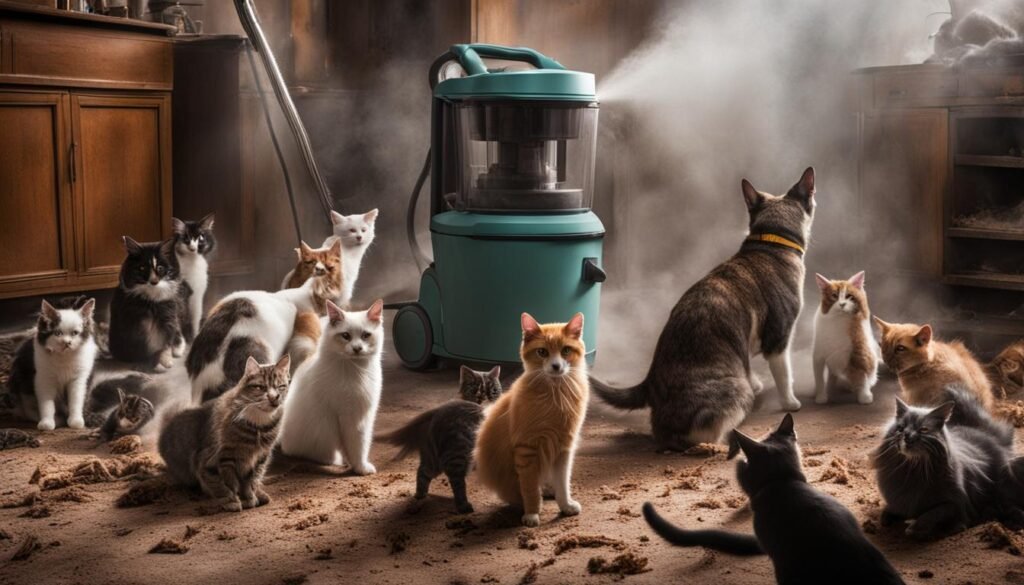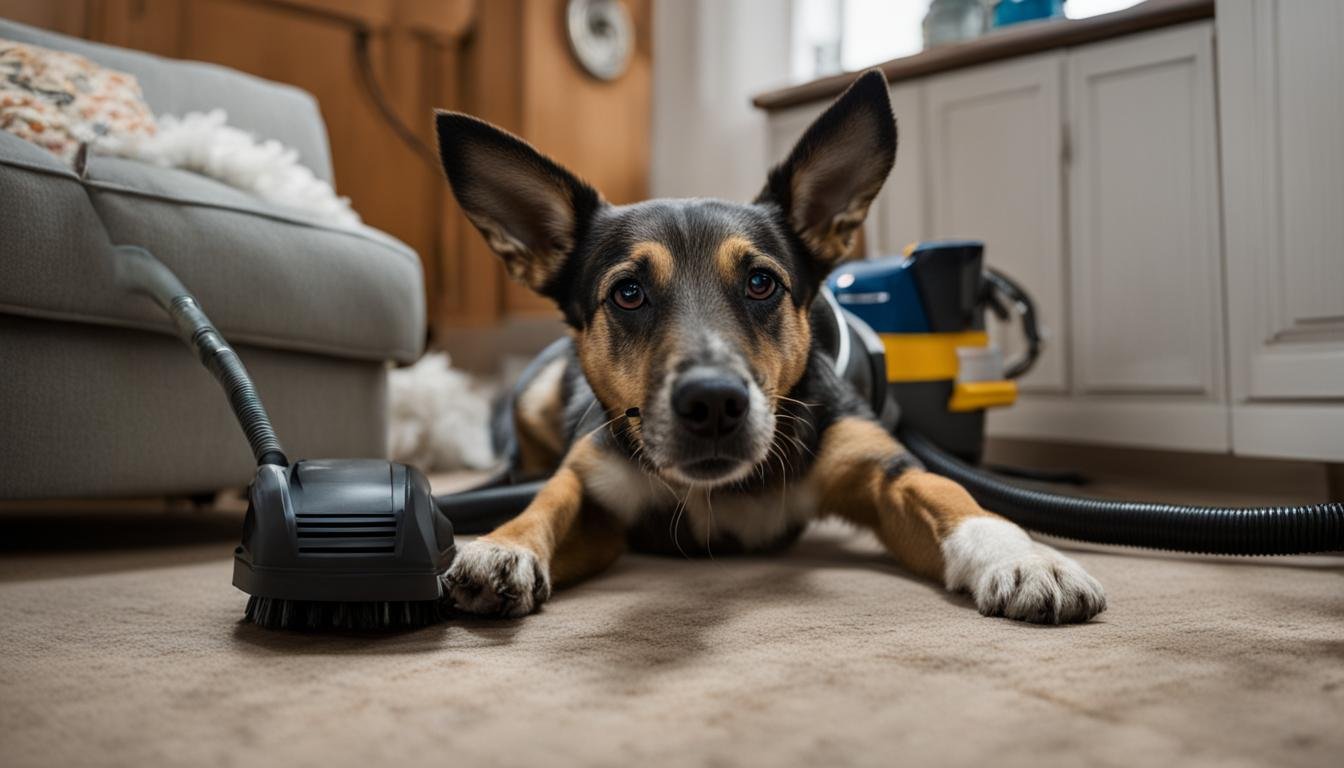Have you ever noticed your dog’s reaction when you turn on the vacuum cleaner? Many dogs exhibit fear or discomfort in the presence of this common household appliance. But why do dogs hate vacuum cleaners? Let’s explore the reasons behind their behavior and discover how we can help our furry friends overcome their anxiety.
Dogs have sensitive hearing, which means they perceive sounds at a much higher frequency than humans. The loud noise produced by vacuum cleaners can be overwhelming and disruptive to them. Additionally, the aggressive movement and unfamiliarity of the vacuum cleaner can add to their fear and discomfort.
Some dogs may have a predisposition to fear or anxiety, making them more susceptible to being scared of the vacuum cleaner. Negative experiences or teasing with the vacuum can also contribute to their fear and reinforce the association between the appliance and a perceived threat.
When dogs are afraid of the vacuum cleaner, they may display various fear responses, such as barking, lunging, hiding, or even attempting to attack the machine or protect their owners. It’s important to address their anxiety and help them develop new, positive associations with this everyday household item.
Key Takeaways:
- Dogs may hate vacuum cleaners due to their loud noise and aggressive movement.
- Some dogs have a predisposition to fear or discomfort, making them more susceptible to vacuum cleaner anxiety.
- Negative experiences or teasing with the vacuum can contribute to a dog’s fear.
- Counterconditioning and desensitization techniques can help dogs develop new reactions to the vacuum.
- Introducing the vacuum gradually, using positive rewards, and avoiding punishment are crucial in training dogs to feel more comfortable around it.
Training Dogs to Tolerate Vacuum Cleaner
Helping dogs overcome their fear of the vacuum cleaner requires patience and positive training techniques. By establishing a positive association with the vacuum cleaner, dogs can learn to tolerate its presence and even feel more comfortable around it.
To start the training process, introduce the vacuum cleaner from a distance while it is turned off. This allows the dog to become familiar with its presence without feeling overwhelmed. Use small treats as rewards for calm behavior during this initial introduction.
Gradually, start moving the vacuum cleaner closer to the dog while still turned off. Continue to reward their calm behavior with treats and praise. This step-by-step approach helps desensitize the dog to the vacuum cleaner’s proximity.
Once your dog is comfortable with the vacuum cleaner nearby, you can start turning it on for short periods. Again, reward their calm behavior with treats and praise during these sessions. It’s important to create a positive and calm environment during vacuuming sessions, as this will help reinforce positive associations with the vacuum cleaner.
If your dog becomes overwhelmed or anxious during the training process, it’s important to take breaks and allow them to retreat to a safe space. This can help them feel more in control and reduce their anxiety. Remember, every dog is unique, and the training process may take time and multiple sessions.
Training dogs to tolerate the vacuum cleaner requires patience and positive reinforcement. By gradually introducing the vacuum cleaner, rewarding calm behavior, and creating a calm environment, dogs can learn to feel more comfortable around this common household appliance.
It’s also helpful to use a quieter vacuum cleaner, as the noise can be a major source of fear for dogs. Dog-friendly vacuum cleaners, specifically designed to be less noisy and have a gentler suction, are available on the market. These vacuum cleaners reduce the overall stress and anxiety for both the dog and the owner during cleaning sessions.
Remember, the goal is to help your dog associate the vacuum cleaner with positive experiences. By implementing these training techniques and using a dog-friendly vacuum cleaner, you can reduce your dog’s anxiety around the vacuum cleaner and create a more peaceful cleaning routine for both of you.
Recommended Steps to Train Dogs to Tolerate Vacuum Cleaner
- Introduce the vacuum cleaner from a distance while turned off
- Reward calm behavior with small treats
- Gradually move the vacuum cleaner closer while turned off
- Continue rewarding calm behavior with treats and praise
- Turn on the vacuum cleaner for short periods while rewarding calm behavior
- Create a positive and calm environment during vacuuming sessions
- Take breaks and allow the dog to retreat to a safe space if needed
- Consider using a quieter, dog-friendly vacuum cleaner
Helping Cats and Dogs with Vacuum Cleaner Anxiety
Dogs and cats can often feel scared and anxious when it comes to vacuum cleaners. The loud noise, aggressive movement, and unfamiliar smell can trigger stress and fear in our beloved pets. But fear not! There are ways to help your furry friends get used to the vacuum cleaner and create a positive association with it.
To start, it’s important to introduce your pets to the vacuum cleaner gradually. Begin by placing a non-running vacuum at a distance from your pet, allowing them to explore it at their own pace. Reward calm behavior with treats and praise, so they start associating the vacuum with positive experiences.
As your pet becomes more comfortable, you can gradually move the vacuum closer and turn it on for short periods. Reward them for remaining calm and relaxed during these sessions. The key is to go at their pace and never force them into uncomfortable situations.
Dividing your vacuuming sessions into shorter, manageable periods can also help reduce anxiety for your pets. This allows them to have breaks and ensures they don’t become overwhelmed by the prolonged exposure to the vacuum cleaner.
Creating a safe space for your pets during vacuuming is essential. This can be a designated area in a different room where your pets can go to retreat and feel secure. Equip the area with their favorite toys, blankets, or beds, making it a comforting environment where they can relax while you clean.
Remember, not all pets may fully accept or overcome their fear of the vacuum cleaner. It’s important to prioritize their health and well-being above all else. If your pet continues to show signs of anxiety despite your efforts, consider seeking professional help from a veterinarian or animal behaviorist.
With patience, positive reinforcement, and a safe environment, you can help your cats and dogs feel more at ease around the vacuum cleaner. Soon enough, they may even view it as just another part of their daily routine!

Conclusion
Vacuum cleaner anxiety is a common issue for both dogs and cats, stemming from the noise, movement, and unfamiliarity of the appliance. However, with proper training and positive reinforcement techniques, pets can learn to tolerate and even feel more comfortable around the vacuum cleaner.
The key to helping pets with vacuum cleaner anxiety is to gradually introduce the vacuum at a distance and create positive associations with treats and rewards. By doing so, we can help them form new, positive memories and associations with the vacuum cleaner, reducing their fear and anxiety.
Additionally, providing a safe space for pets to retreat to during vacuuming sessions can greatly help alleviate their anxiety. A designated area where they can feel secure and protected will give them a sense of control and help them cope better with the presence of the vacuum cleaner.
While not every pet may fully accept the vacuum cleaner, it’s essential to prioritize their well-being and seek professional help if needed. Remember, every pet is unique, and their responses and progress may vary. With patience, understanding, and a gentle approach, we can create a positive environment and help our beloved dogs and cats overcome their fear of the vacuum cleaner.
FAQ
Do dogs hate vacuum cleaners?
Many dogs have a negative reaction to vacuum cleaners due to their loud noise and aggressive movement. Dogs may show fear responses such as barking, lunging, hiding, or attempting to protect their owners from the perceived threat of the vacuum.
How can I help my dog with their fear of the vacuum cleaner?
You can help your dog by introducing the vacuum gradually and at a distance, using high-value treats and praise, and taking breaks when the dog gets overwhelmed. It’s essential to avoid scolding or punishing the dog for their reactions and to never leave the dog unsupervised with the vacuum.
How can I train my dog to tolerate the vacuum cleaner?
To train your dog to tolerate the vacuum cleaner, it’s important to establish a positive association with it. This can be done by introducing the vacuum at a distance while turned off and providing small treats as rewards. Gradually, the vacuum can be moved closer and turned on for short periods while continuing to reward the dog.
What can I do to help my dog feel more comfortable around the vacuum cleaner?
You can help your dog feel more comfortable around the vacuum cleaner by creating positive and calm environments during vacuuming sessions, using a quieter vacuum if possible, and desensitizing them through gradual exposure and positive associations. It may take time and multiple training sessions to achieve this.
Are cats scared of vacuum cleaners too?
Yes, cats can also be scared of vacuum cleaners due to the loud noise, aggressive movement, and unfamiliar smells associated with them.
How can I help my pets get used to vacuum cleaners?
To help your pets get used to vacuum cleaners, you can introduce them to a non-running vacuum at a distance and reward calm behavior with treats and praise. Gradually, the vacuum can be moved closer and turned on for short periods while continuing to reward your pets.
What should I do if my pet is still anxious around the vacuum cleaner?
If your pet is still anxious around the vacuum cleaner, it’s important to prioritize their health and well-being by recognizing signs of anxiety and seeking professional help if needed. Not all pets may fully accept the vacuum, and it’s essential to respect their boundaries and provide them with a safe space to retreat to during vacuuming sessions.
Can robot vacuums scare dogs too?
Yes, robot vacuums can also be intimidating to dogs. It’s best to supervise their interactions with the autonomous cleaner and ensure they feel safe and comfortable around it.





Leave a Reply